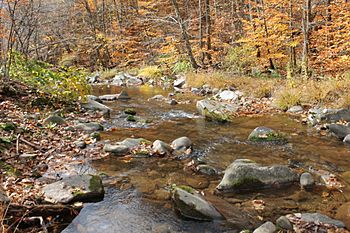Broadstreet Hollow Creek facts for kids
Quick facts for kids Broadstreet Hollow Creek |
|
|---|---|
 |
|
|
Location of mouth within New York
|
|
| Country | United States |
| State | New York |
| Region | Catskill Mountains |
| Counties | Greene, Ulster |
| Towns | Lexington, Shandaken |
| Physical characteristics | |
| River mouth | Esopus Creek Allaben 42°06′40″N 74°21′35″W / 42.111118°N 74.359653°W |
Broadstreet Hollow Creek or Broadstreet Hollow Brook is a stream located in New York. It starts its journey in the town of Lexington in Greene County. From there, it flows south through the town of Shandaken in Ulster County. Finally, it joins the Esopus Creek.
The creek was named after Major John Bradstreet. He was an officer in the English Army during the French and Indian War. He is well-known for his attack on Fort Frontenac.
Contents
What is the Broadstreet Hollow Creek Watershed?
Broadstreet Hollow Creek is the second largest stream that flows into Esopus Creek in its area. Its watershed, which is the land area that drains water into the creek, covers 9.2 square miles. The creek itself is 5.5 miles long.
The creek begins high up on the southern slopes of West Kill Mountain. It flows southwest for about 3.9 miles. Then, it turns south and continues its journey until it meets the Esopus Creek. This meeting point is about 1,500 feet downstream from the Shandaken Tunnel outlet.
The Landscape Around the Creek
The land around Broadstreet Hollow Creek is very mountainous. It has steep slopes and is almost entirely covered by forests, about 99.5 percent. The valley at the bottom of the creek is narrow. This means there isn't much flat land next to the stream where water can spread out during floods.
Broadstreet Hollow Creek flows next to Broadstreet Hollow Road for its lower half. It passes under nine bridges along the way. Because the valley is so narrow and there are roads and bridges, the creek's path is very limited. Many homes are built close to the stream. This closeness, combined with the small floodplain, means these homes could be at risk if the water levels get very high.
How Was Broadstreet Hollow Creek Formed?
The land around Broadstreet Hollow Creek has a similar geological makeup to Bushnellsville Creek. The surface of the land is made up of materials left behind by glaciers and rivers. These materials include glacial till, which is a mix of rock and soil dropped by glaciers, and alluvium, which is sediment deposited by flowing water.
Scientists have also found lacustrine clay in the creek's banks and bed. This type of clay forms in lakes. The deeper rock layers, called bedrock, include red shales and mudstones. There are also grey sandstones and grey shales. However, you can't see the bedrock at the bottom of the valley. This is because it's covered by very thick layers of glacial sediment.
What Happened During the 1996 Flood?
On January 19, 1996, the Catskill Mountains experienced a big flood. It was caused by heavy rain in the middle of winter and unusually warm temperatures. This warm weather quickly melted a lot of snow, leading to extreme runoff and widespread flooding.
During this flood, a small part of Broadstreet Hollow Creek eroded about thirty feet. This erosion damaged one home and put several others at risk. To help, the Natural Resources Conservation Service (NRCS) stepped in. They provided aid through the Emergency Watershed Protection Program.
Restoring the Creek After the Flood
The emergency project rebuilt the streambank. They also stabilized another 475 feet of the streambank to prevent more damage. During this work, the contractors faced problems with clay deposits. When these clays were exposed, they made the water very cloudy, a condition called turbidity.
The project also led to a loss of protection for the streambed. This happened because the coarse materials from the streambed were used to fix the eroded streambank. Removing these materials exposed deep layers of glacial and lacustrine clay.
Later Challenges for the Creek
Between early 1996 and late 1999, the creek faced serious problems. It experienced severe degradation, which means it got worse over time. This led to more bank erosion and large amounts of clay being washed into the stream channel.
In the fall of 1999, Tropical Storm Floyd caused even more damage to the stream channel. The channel quickly cut deeper into the ground. This created a constant flow of cloudy groundwater coming up from below. The water remained cloudy, or turbid, even during low and high flows. This cloudy condition continued from the project site all the way to the Esopus Creek.



